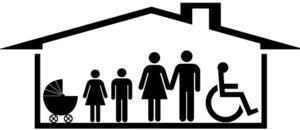Universal Design
The concept of “Handicap Accessible” quickly changed to “Universal Design” or “Aging in Place Design” as new products and techniques made sense for all of us – not just those with physical & emotional restrictions, or those suffering with memory loss issues.
For instance:
- What if you broke your leg, or you were pregnant, or traveling for an extended period of time in a country that you don’t speak the language? How would you open the door and turn on the lights, heat, or A/C? Be able to reach for the groceries on the second shelf of the wall cabinet while you’re on crutches, or have a pregnant belly in the way?
- If a lever door handle makes it easier for grandma who has arthritis, to open a door, it also makes it easier for a 28 year old with arms full of groceries.
- If soft/ diffused lighting, on a motion sensor, makes it safer for grandpa to go to the bathroom at night, it also makes it safer for a young child, who could trip on toys left out on the floor.
- Installing child-lock appliances is helpful to families with memory-loss relatives living within the same household. A cooktop or oven is not accidentally turned on, and left on, all day.
- Appliances with smart-technology allows mom to call the child care person to take dinner from the frig and put into the oven, as mom leaves work. Mom can then control the oven from her IPAD & walk into a warm dinner. Feeding the family healthier meals made from scratch, instead of fast-food.
- Security systems that alert a care-giver if a medicine cabinet door/ medication has been opened, so mom doesn’t forget her diabetes pills, is another great technology that can be utilized in an “Aging in Place” residence.
- Clearances for both a seated user and a care-giver is a must. Not just for wheelchairs, but also for a gurney. If the EMT’S are called, the first piece of equipment brought in is a gurney!
My grandmother had a leg amputated, due to an infection. She never left her hospital bed, at home, unless someone carried her, on double 2 x 12’s, because the doorways were too narrow for a wheelchair and there wasn’t a ramp at the front door.
The crank hospital bed was considered the best technology at that time. If you were the “good grandchild” of the day, you were allowed to crank the bed so grandma could sit up. No electric controls in her day.
I have a passion to suggest ideas and provide dignity & style to those who need Universal Design now, or those who want to plan their living spaces for the future.
– Debra Bishop, UDCP
Universal Design Certified Professional

